Abstract
In the ever-changing global energy landscape, the emergence of ‘prosumers’, individuals who both produce and consume energy, has blurred traditional boundaries. Driven by the growing demand for sustainability and renewable energy, prosumers play a critical role in bridging the gap between energy production and consumption. They can generate their own energy through decentralized sources like solar panels and wind turbines, and sell excess energy back to the grid. However, tracking carbon emissions and pricing strategies for prosumers pose challenges. To address this, we developed an innovative blockchain-driven peer-to-peer (P2P) trading platform for carbon allowances. This platform empowers prosumers to influence pricing and promotes a more equitable distribution of energy. The P2P platform leverages blockchain technology, a decentralized digital ledger, to provide transparency and security in carbon emission tracking and energy transactions. By eliminating intermediaries, blockchain ensures the accuracy of data and creates a tamper-proof record of energy production and consumption. This study employed a modified IEEE 37-bus test system to evaluate the efficacy of the proposed blockchain-based trading framework. The IEEE 37-bus system is a well-established benchmark for power system analysis, comprising 37 nodes, 13 generators, and 37 transmission lines. By leveraging this test system, this study demonstrated the framework’s ability to optimize energy consumption patterns and mitigate carbon emissions, highlighting the transformative potential of blockchain technology in the energy sector. The proposed P2P trading platform offers several benefits for prosumers: (1) Transparency: The blockchain-based platform provides a transparent record of all energy transactions, ensuring that prosumers are compensated fairly for the energy they produce. (2) Security: Blockchain technology makes it impossible to tamper with or counterfeit carbon allowances, ensuring the integrity of the trading system. (3) Efficiency: The P2P trading platform eliminates the need for intermediaries, reducing the cost and complexity of energy transactions. (4) Empowerment: The platform gives prosumers a greater say in how their energy is priced and distributed, promoting a more equitable energy system.
1. Introduction
Climate change poses a grave threat to our planet, demanding bold solutions for greenhouse gas emission reduction. Carbon trading has emerged as a pivotal tool to incentivize emission reductions, allowing polluters to offset their impact by acquiring carbon credits from entities that have reduced their emissions. However, traditional carbon trading systems have faced criticism due to inefficiencies, a lack of transparency, and high transaction costs. Blockchain technology presents a promising solution to these challenges, enabling the creation of a more transparent, efficient, and equitable carbon market [,]. Carbon trading is a market-based approach to reducing greenhouse gas emissions, which allows companies to buy and sell permits to emit carbon dioxide and other greenhouse gases. The idea behind carbon trading is to create a financial incentive for companies to reduce their emissions by allowing them to offset their impact by acquiring carbon credits from entities that have reduced their emissions. This approach has been widely adopted by governments and organizations worldwide, with the European Union Emissions Trading System (EU ETS) being the largest carbon market in the world []. Despite the potential benefits of carbon trading, traditional systems have faced several challenges, including inefficiencies, a lack of transparency, and high transaction costs. These issues have hindered the effectiveness of carbon trading as a tool for climate change mitigation []: (1) Inefficiencies: Traditional carbon trading systems often suffer from inefficiencies due to the complex nature of the market and the lack of standardization in carbon credit verification. This can lead to delays in the trading process and increased costs for participants. (2) Lack of transparency: The lack of transparency in traditional carbon trading systems can lead to fraud and manipulation, undermining the credibility of the market. This can discourage participation and reduce the effectiveness of carbon trading as a tool for climate change mitigation. (3) High transaction costs: The high transaction costs associated with traditional carbon trading systems can deter participation and limit the effectiveness of the market. These costs can include fees for verification, registration, and trading, as well as the costs of managing and maintaining the carbon credit registry. Blockchain technology presents a promising solution to the challenges faced by traditional carbon trading systems. By providing a decentralized, transparent, and secure platform for carbon trading, blockchain can help to address the inefficiencies, lack of transparency, and high transaction costs that have hindered the effectiveness of carbon trading as a tool for climate change mitigation [,]: (1) Transparency: Blockchain technology provides a transparent and immutable record of all carbon credit transactions, ensuring that the market is free from fraud and manipulation. This can help to build trust and confidence in the carbon market, encouraging participation and increasing the effectiveness of carbon trading as a tool for climate change mitigation. (2) Efficiency: Blockchain technology can help to streamline the carbon trading process by automating many of the tasks associated with carbon credit verification, registration, and trading. This can reduce delays and increase the efficiency of the market, making it more attractive to participants. (3) Low transaction costs: Blockchain technology can help to reduce the transaction costs associated with carbon trading, by eliminating the need for intermediaries and centralized authorities. This can make the market more accessible to a wider range of participants, increasing the effectiveness of carbon trading as a tool for climate change mitigation. In addition to the benefits of blockchain technology for carbon trading, the transition to renewable energy sources like solar, hydroelectric, and wind energy can also play a crucial role in climate change mitigation. By replacing fossil fuels with renewable energy sources, we can reap significant environmental benefits, including reduced greenhouse gas emissions, improved air quality, and conservation of natural resources []. Moreover, the transition to renewable energy fosters job creation, economic growth, and resilience to climate change, contributing to a more sustainable and environmentally friendly energy system. As such, the combination of blockchain technology for carbon trading and the transition to renewable energy sources represents a powerful approach to addressing the challenges of climate change and building a more sustainable future for our planet.
1.1. Traditional Carbon Trading: Challenges and Limitations
Traditional carbon trading systems rely on centralized platforms and intermediaries to facilitate the trading of carbon allowances []. These systems often suffer from the following issues:
- Inefficiencies: The involvement of multiple intermediaries can add unnecessary delays and costs to the trading process.
- Opacity: The lack of transparency in traditional systems makes it difficult to track the origin and ownership of carbon allowances, leading to concerns about fraud and double-counting [].
- High transaction costs: The involvement of intermediaries and the need for complex verification processes can inflate transaction costs, reducing the accessibility of carbon trading for smaller participants [].
Blockchain is a distributed ledger technology that records transactions securely and transparently. It has gained widespread recognition for its potential to revolutionize various industries, including finance, supply chain management, and healthcare. In the context of carbon trading, blockchain can facilitate the creation of decentralized, tamper-proof platforms where prosumers (both producers and consumers of energy) can trade carbon allowances directly with each other. This eliminates the need for intermediaries, reducing transaction costs and increasing transparency []. Blockchain technology offers several key benefits for carbon trading:
- Transparency: Blockchain’s distributed ledger provides a secure and transparent record of all transactions, making it easy to track the origin and ownership of carbon allowances. This reduces the risk of fraud and double-counting.
- Efficiency: By eliminating intermediaries and automating processes, blockchain can significantly reduce the time and costs involved in carbon trading.
- Equitability: Blockchain-based platforms can create a more level playing field for smaller participants, reducing barriers to entry and fostering wider participation in carbon trading [].
- Traceability: Blockchain can provide real-time tracking of carbon allowances, ensuring that they are used for their intended purpose and not double-counted.
1.2. Empowering Prosumers in Local Energy Trading
The integration of renewable energy sources and the rise of prosumers are transforming the energy landscape. Prosumers can generate and store their own electricity, contributing to the local energy grid and reducing their reliance on traditional fossil fuels. Local energy trading platforms, facilitated by blockchain technology, can enable prosumers to trade excess electricity with each other, balancing supply and demand within communities. Blockchain technology has the potential to revolutionize carbon trading, creating a more transparent, efficient, and equitable market. By eliminating intermediaries, reducing transaction costs, and providing real-time tracking of carbon allowances, blockchain can help accelerate the transition to a low-carbon economy. As the integration of renewable energy sources and the rise of prosumers continue to reshape the energy landscape, blockchain-based solutions will play a crucial role in empowering local energy trading and fostering a more sustainable future.
2. State of the Art
Carbon trading has emerged as a critical mechanism for mitigating climate change, by providing financial incentives to reduce greenhouse gas emissions []. Blockchain technology, with its decentralized, immutable, and transparent nature, has the potential to transform carbon trading by enhancing transparency, reducing transaction costs, and improving the overall efficiency of the market. This section presents a literature review of carbon trading platforms based on blockchain, examining their key features, benefits, and challenges. The emergence of blockchain technology has indeed catalyzed the development of innovative carbon trading marketplaces, promising to revolutionize the way carbon credits are bought and sold. Below are some of these systems:
- Climate Chain Coalition (CCC) (https://www.climatechaincoalition.io/, accessed on 20 April 2024): The Climate Chain Coalition is a notable consortium comprised of various organizations, including governments, NGOs, and businesses, working towards the implementation of blockchain technology in carbon trading. The CCC aims to develop a blockchain-based platform to enhance transparency and efficiency in carbon markets. (Climate Chain Coalition).
- Verra (https://verra.org/, accessed on 20 April 2024), a prominent non-profit organization, is actively involved in the development of a blockchain-based carbon registry. Through their efforts, Verra aims to create a transparent and immutable ledger for carbon credits, ensuring credibility and traceability in carbon markets.
- IBM Food Trust (https://www.ibm.com/blockchain/solutions/food-trust, accessed on 20 April 2024): While primarily focused on food supply chain transparency, the IBM Food Trust has also ventured into carbon trading. Leveraging blockchain technology, the IBM Food Trust has introduced a carbon trading marketplace, enabling participants to buy and sell carbon credits securely and transparently. (IBM Food Trust).
The current state of the art in carbon and energy trading on blockchain demonstrates the potential of this technology for addressing the challenges of the global energy market. The research methods employed in these studies, including the use of systematic literature reviews and the analysis of key findings and contributions, provide a solid foundation for future research in this field. As the adoption of blockchain technology continues to grow, it is likely that carbon and energy trading on blockchain will play an increasingly important role in the transition to a low-carbon economy [].
- Enhanced transparency and trust: Blockchain technology provides a transparent and tamper-proof platform for carbon and energy trading, ensuring that all transactions are recorded and verified by the network. This increases trust among participants and reduces the risk of fraud and manipulation [].
- Improved efficiency and cost savings: The use of smart contracts in carbon and energy trading on blockchain significantly reduces transaction costs and processing times, as they automate the execution of agreements between buyers and sellers [].
- Increased liquidity and market access: Blockchain-based carbon and energy trading platforms enable smaller players, such as households and small businesses, to participate in the market, increasing liquidity and market access [].
- Integration with renewable energy sources: Blockchain technology can facilitate the integration of renewable energy sources into the grid, by enabling the trading of energy assets, such as solar and wind power, on a peer-to-peer basis [].
- Environmental benefits: Carbon and energy trading on blockchain has the potential to reduce greenhouse gas emissions and promote the transition to a low-carbon economy, by incentivizing the adoption of clean energy technologies and practices [].
2.1. Key Features of Blockchain-Based Carbon Trading Platforms
- Decentralization: Blockchain eliminates the need for intermediaries, allowing direct transactions between participants.
- Immutability: Transactions recorded on the blockchain are permanent and tamper-proof, ensuring data integrity.
- Transparency: All transactions are visible to all participants, promoting accountability and trust [].
- Automation: Smart contracts can automate processes, reducing manual labor and increasing efficiency.
- Tokenization: Carbon credits can be represented as tokens on the blockchain, facilitating easy trading and settlement.
2.2. Benefits of Blockchain-Based Carbon Trading Platforms
- Enhanced transparency: Blockchain provides a transparent and auditable record of all transactions, reducing the risk of fraud and double-counting [].
- Reduced transaction costs: By eliminating intermediaries, blockchain can significantly reduce transaction costs compared to traditional carbon trading platforms.
- Improved efficiency: Automation and tokenization streamline processes, making carbon trading faster and more efficient.
- Increased accessibility: Blockchain-based platforms can connect buyers and sellers from around the world, broadening market participation.
- Enhanced environmental integrity: The immutability and transparency of blockchain help ensure that carbon credits represent genuine emission reductions.
2.3. Challenges of Blockchain-Based Carbon Trading Platforms
Blockchain technology has the potential to revolutionize the carbon trading market by enhancing transparency, reducing transaction costs, and improving efficiency. However, challenges related to scalability, regulatory compliance, and interoperability need to be addressed for widespread adoption. As these challenges are overcome, blockchain-based carbon trading platforms are expected to play an increasingly significant role in mitigating climate change, by facilitating cost-effective and environmentally sound carbon emission reductions. Blockchain technology provides robust security features that render it highly resistant to fraud and hacking attempts. The immutability of blockchain records ensures the integrity of carbon credit transactions, preventing unauthorized alterations and preserving the authenticity of data []. Transactions on blockchain are publicly recorded and transparent, offering stakeholders a comprehensive view of carbon credit trading activities. This transparency fosters trust and accountability in carbon markets, promoting ethical and responsible trading practices. By automating various processes, such as verification and settlement, blockchain enhances the efficiency of carbon trading marketplaces. Smart contracts enable seamless execution of agreements, reducing administrative overheads and streamlining the overall process. Despite their advantages, blockchain-based carbon trading marketplaces face challenges in terms of scalability. As the volume of transactions increases, existing blockchain networks may struggle to handle the load efficiently. Achieving interoperability between different blockchain platforms is crucial for seamless integration and widespread adoption of blockchain in carbon markets. Despite these challenges, the potential benefits of blockchain for carbon trading marketplaces are undeniable []. As the technology matures and scalability solutions are developed, the adoption of blockchain-based platforms is expected to accelerate, contributing significantly to the fight against climate change [,]. To address these challenges, this study proposes a decentralized carbon trading system based on blockchain, leveraging its inherent security, transparency, and efficiency to facilitate ethical and effective carbon trading practices.
We developed an innovative blockchain-driven peer-to-peer (P2P) trading platform for carbon allowances []. The proposed platform introduces several novel features that address the limitations of existing carbon trading systems:
- Empowering prosumers: The proposed platform enables prosumers to actively participate in the carbon market, influencing pricing and contributing to a more equitable distribution of energy [,].
- Transparency and traceability: All transactions on the proposed platform are recorded on the blockchain, providing a transparent and auditable record of carbon allowance ownership and transfers.
- Reduced transaction costs: By eliminating intermediaries and automating processes, the platform significantly reduces transaction costs, making it more accessible for both buyers and sellers of carbon allowances.
- Increased liquidity: The P2P marketplace provides a highly liquid market for carbon allowances, ensuring that buyers and sellers can easily find counterparties for their trades [].
The proposed blockchain-powered carbon trading platform has the potential to transform energy markets and contribute to the fight against climate change. By empowering prosumers and increasing transparency, the platform achieves the following:
- Promotes emission reductions []: The platform incentivizes prosumers to reduce their emissions to generate carbon allowances, contributing to overall emission reductions.
- Supports sustainable energy development: By making carbon allowances more accessible and affordable, the platform supports the development of sustainable energy sources, such as renewable energy and energy efficiency measures [].
- Fosters equitable energy distribution []: The platform empowers prosumers to influence pricing and to benefit from their efforts to reduce emissions, promoting a more equitable distribution of energy resources.
The proposed blockchain-driven carbon trading platform offers a transformative solution to the challenges of traditional carbon markets [,]. By empowering prosumers, increasing transparency, and reducing transaction costs, the platform contributes to the creation of a more efficient, equitable, and sustainable energy system.
3. Proposed Carbon Trading Framework
The proposed trading model for carbon allocation in distribution networks, as outlined in Figure 1, is a multi-level system that involves various players, including the ”microgrid-trader (MT)"”. It operates on a daily basis, to plan energy usage and conduct transactions for the following day. The system is divided into three levels: transactions focused on the prosumer, trading centered around the MT, and a direct peer-to-peer trading platform. Prosumers, who actively engage in carbon markets and energy systems using distributed renewable energy sources (DRESs), participate in this system to gain personal benefits such as cost reductions and environmental objectives. The increasing adoption of DRESs in distribution networks has fueled interest in carbon trading as a mechanism to incentivize the reduction of greenhouse gas emissions. However, existing carbon trading models are not tailored to distribution networks, as they are typically designed for large-scale generators. The proposed model addresses this gap by providing a framework for carbon trading that is specifically designed for the unique characteristics of distribution networks.
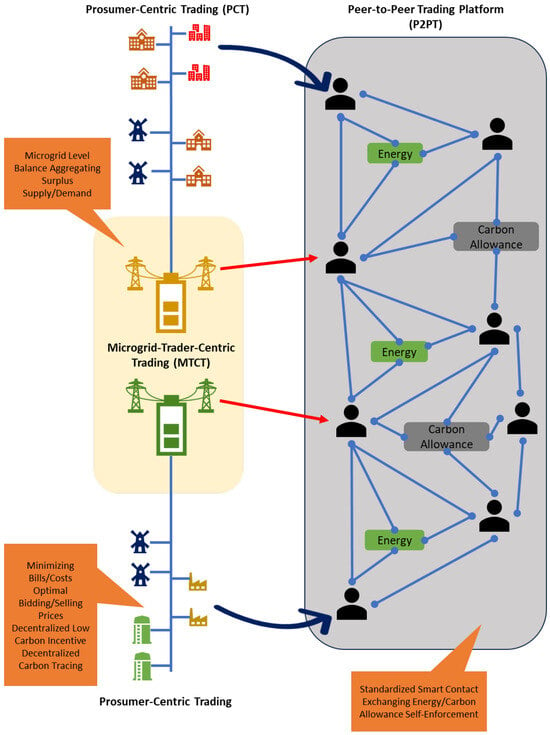
Figure 1.
Proposed trading framework architecture.
The market transaction acts as the main nodes in the transaction system, providing the necessary energy for schemes and receiving rewards for successfully mining blocks. Prosumers and microgrid traders (MTs) operate as lighter mechanisms, storing the head chain and verifying operations. As these are lighter phases, prosumers and MTs do not need high-powered systems, allowing transactions to be conducted using innovative meters or even mobile phones. Figure 1 illustrates three trading modules.
3.1. Prosumer-Centric Transaction
The transaction level for prosumers is designed to incorporate data from meter readings to help them make informed decisions about their energy usage and bidding prices. These decisions are based on solving optimization challenges, to minimize costs for buyers and maximize profits for sellers. Controllers are responsible for implementing the chosen energy usage decisions, while the bidding price decisions are communicated through an innovative auction contract []. Additionally, the blockchain automatically updates the financial rewards for each prosumer by monitoring their carbon emission behavior. This prosumer-focused trading system is limited to individuals within the same microgrid area, ensuring a balanced energy distribution and reducing losses during transmission.
Prosumer-focused trading offers numerous advantages: (1) Empowering prosumers to directly influence changes in energy consumption through their own bids and selling prices, rather than being subject to the control of a central authority like an aggregator or energy retailer; (2) Providing financial incentives for prosumers to decrease their carbon emissions, with rewards tailored to each individual’s emission-reducing actions
3.2. Microgrid-Trader-Centric Trading
A microgrid trader (MT) is a virtual entity that oversees a group of physically connected prosumers. At the MT-focused trading level, the MT collects any excess energy transactions from its prosumer group and engages in transactions with other MTs. To determine the most efficient bidding costs, optimization problems with similar objectives to those in prosumer-focused trade are formulated []. The goal of MT-focused trading is to facilitate an energy balance among a group of prosumers within a microsystem by trading with other microgrids.
3.3. P2P Trading Platform
The P2P trading platform level offers a standardized process for self-managed settlements, specifically for the trading of energy and fuel allowances. The execution of a smart contract involves several steps, such as setting it up, pairing bids and offers, bidding, choosing a winner, and changing possession []. This innovative system is initiated by the vendor, who sets up the offer settings. Interested buyers who meet these conditions will be matched and can place their bids on the auction contract.
4. Materials and Methods
This section delves into the evaluation of the hierarchical three-phase transaction model as shown in Figure 1. It also explores the decentralized low-carbon incentive system. In traditional power structures, monitoring the emissions from extended energy-powered fuels is crucial. In order to adhere to carbon regulations, these expansive systems are required to disclose their yearly fuel consumption and electricity generation, in order to assess their efficiency. By simplifying the network characteristics, we can evaluate the carbon emissions generated by the actions of prosumers at each bus point.
4.1. Materials
Figure 1 shows a detailed diagram explaining how to track the three types of carbon emissions. Let us call the energy systems index ‘I’ and the prosumer’s loads ‘K’. ‘ri,t’ represents the rate of fuel emissions produced by power generation from source i (which is ∈I) at the scheduled time t. ‘’ represents the rate of emissions by the power usage behavior of load k (which is in the set K) at the scheduled time t. These rates are measured in grams per hour (g/h). The part of the carbon release created by prosumer A and prosumer B using their generated energy to meet their needs can be measured by
respectively. Additionally, the part of emissions due to incorporating prosumers’ production for supplying additional prosumer demand is determined as follows:
where ‘’ represents the quantity of discharge produced by prosumers incorporating generated energy to meet the demands of other prosumers at the scheduled time t. Moreover, to primarily focus on prosumers with high carbon emissions, the monetary reward for high emissions is greater than for low levels. This mechanism implies that the incremental financial compensation grows as the level of carbon emissions increases.
In this equation, y(·) represents the prosumer’s financial reimbursement function, with a unit of . The low discharge can be derived by
where represents the financial reimbursement rate with a measure of /g, and t comprises the arrangement phase.
4.1.1. Prosumer-Based Algorithm
Prosumer-based transactions allow prosumers within a similar microgrid to swap power with nearby prosumers to maintain regional balance. If a prosumer cannot generate enough capacity to satisfy their needs, they have to purchase energy from others, acting as an energy purchaser. The goal of a prosumer in the role of an energy purchaser is to reduce costs by smartly focusing on energy bidding prices and adjusting their energy consumption and production behavior,
where g, i, d, k, b, energy
where ‘dk,t’ signifies the power used by a prosumer’s coverage ‘k’ (part of set K) at the scheduled time ‘t’, ‘,t’ represents the power generated by a source ‘i’ (part of set I) at the scheduled time ‘t’, and ‘t’ signifies the cost of a prosumer at the scheduled time ‘t’ for purchasing power, which is measured in pounds ().
4.1.2. Microgrid-Trader Algorithm
Once the prosumer-focused transaction has been completed, there may still be leftover demand and supply within the microgrid that cannot be met. This process can occur due to an excess or shortage of energy generation from all the prosumers within the same microgrid. MT-based trading seeks to aid prosumers in a similar microgrid to integrate the residual demand and supply. The standard power production of the defined source I and load k power consumption are represented by g and d, respectively. Assuming N represents the prosumer index set in a similar microgrid, the overall power generation and expenditure for each prosumer are determined as follows:
In (8) and (9), G represents the overall power generation of the prosumer. In addition, D represents the total power consumption within the scheduled time t.
4.1.3. Innovative Contract-Based Auction System
In the P2P trading system layer, the suggested auction mechanism for the smart contracts suits both prosumers and microgrid traders (MTs) for transacting power parameters. This takes place under standardized negotiation rules and the self-enforcement of smart contracts. The process comprises initialization, averaging, bidding, withdrawal, and seller-based payment. A function of smart contract undertakes the phase, determined as funit(·), fmatch(·), fbid(·), fwithdraw(·), and fpay(·).
Level 1
Every seller uses the initialization system, ‘finit(·),’ from the innovative contract to detail the locality, type of trade, seller type (MT), microgrid digit, the amount for sale, lowest acceptable bid, current tag, and the end time of the auction, as follows:
In this equation, On represents the offer initialized by the vendor u, E, and U and represents a binary value portraying the trading features in carbon or energy allowance. B E represents a binary value that signifies whether the vendor type is an MT. ‘mu’ stands for the micro seller index ‘u’, helping purchasers locate sellers within the same microsystem. ‘su’ refers to the quantity of power allocation that the seller ‘u’ is offering.
Level 2
In the suggested auction process, each purchaser must place a bid surpassing the current increased bid among all buyers. The proper function ‘fmatch(·)’ assists purchasers in identifying the best combination of offers to place their bids. This is based on two criteria: (1) fulfilling the demand for power allocation of buyer ‘v’ (part of set V), represented as ‘dv’; (2) the chosen optimal systems have the smallest total of the current high bid costs, enabling purchasers to place bids at the lowest possible prices.
Level 3
The bidding framework ‘fbid(·)’ allows purchasers to bid after verifying the underlying conditions: (1) the auction has not ended, meaning the current time ’now’ is less than or equal to ‘’, the auction end phase; (2) the microsystem index of the purchaser ‘v’, represented as ’mv’, fits with ‘mu’; (3) the buyer has a sufficient balance between placing a bid surpassing the current bid as B highest.
Level 4
Once the auction has terminated, for instance, T now > r, the purchaser having an increased bidding cost wins the auction:
where v represents the purchaser with increased bid costs. B represents the bidding price sets issued by all purchasers for the power allocation at organizing time t.
Level 5
Once the innovative contract verifies the energy delivery by checking with the innovative meter, the last highest bid for the offer is confirmed. The equation is shown as follows:
In this equation,
This equation represents the seller’s updated account balance upon obtaining the defined pay.
5. Proposed Use Case
To incorporate the ‘IEEE 37-bus adaptor’ reported in Figure 2, case scenarios were conducted. The distribution was divided into linked microarrays, with randomly allocated diesel propellants and DRESs, such as solar, wind, and bioenergy []. Permanent system demand data were collected using the KAHRAMAA tracking hub. KAHRAMAA tracking hubs were also used to gather demand data for residential loads. The Qatari solar provision of clients provided data on solar power production. The Qatari power retail market and carbon mechanisms were the sources for centralized energy and carbon allowance price data []. These centralized prices served as the minimum acceptable bid for each vendor, ensuring that buyers could offer higher prices by utilizing their objective operations to determine the best prices.
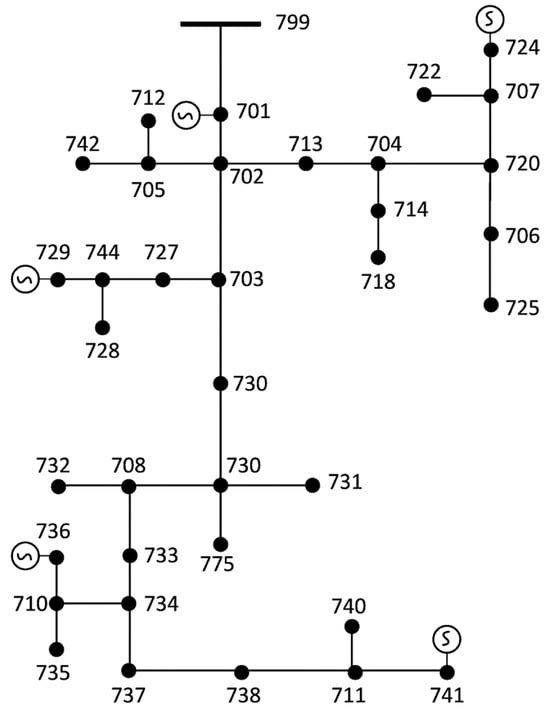
Figure 2.
IEEE Bus 37.
5.1. Standards
In order to evaluate the effectiveness of the suggested trading system, the following trading mechanisms were incorporated as anomalous data points.
5.1.1. Centralized Trading
The act of purchasing and selling energy or carbon allowances is limited to centralized markets. The prices for these trades are determined by the rates observed in centralized markets.
5.1.2. Aggregator-Based Trading
In the [] trading model, aggregators play a crucial role in regulating energy production and consumption. These decentralized entities work to minimize costs for buyers and maximize profits for sellers. Additionally, they offer financial incentives to prosumers who make adjustments to their energy usage. The buying and selling of energy and carbon allowances is solely managed by aggregators.
5.1.3. Leverage of Power Allocation
In Figure 2, the power balance of the IEEE 37-bus trial system is depicted. A positive net energy indicates an excess of power generation compared to the net demand. On the other hand, a negative net power signifies a shortage in total power production to meet the net requirements, resulting in the need for the transmission network to receive power from the primary grid.
6. Experimental Results
In order to assess the effectiveness of the suggested decentralized trading system (shown in Figure 3), we conducted experiments using the modified IEEE 37-bus trial as a testing platform. This trial incorporated practical consumption patterns and generation capacities, making it an ideal environment for simulating energy trading scenarios. By comparing the results of the decentralized approach with those of centralized and aggregator-based methods, we were able to evaluate its performance. In Figure 4, we present the daily energy transfer, while the other figure illustrates the daily reduction in carbon emissions achieved using the three different trading methods.
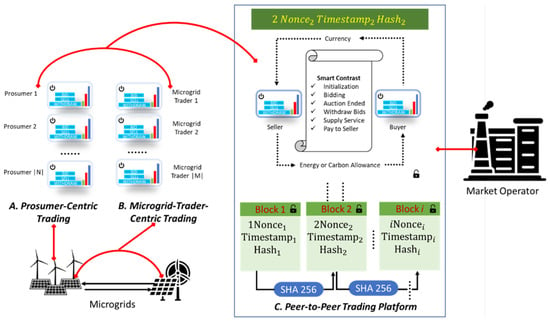
Figure 3.
Trading System Components.
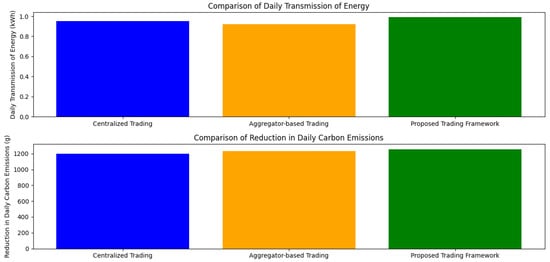
Figure 4.
Comparison of daily transmission of energy and reduction in daily carbon emissions in three scenarios: (1) centralized trading, (2) trading based on aggregation, (3) proposed system.
The proposed trading framework, displayed in green, has been gaining attention due to its superiority in both aspects of energy transmission and carbon emission reduction. This article aims to further explain the reasons behind this phenomenon, focusing on the positive excess carbon allocation and the decentralized low-carbon incentive mechanism. A positive excess carbon allocation signifies that the transmission network’s overall emissions are lower than the designated carbon allocation. This is a result of the proposed trading framework’s ability to optimize energy transmission routes, ensuring that the most efficient and low-carbon routes are utilized. By doing so, the framework reduces the overall carbon emissions associated with energy transmission, leading to a positive excess carbon allocation. This positive excess carbon allocation is a clear indication of the framework’s effectiveness in reducing carbon emissions. It demonstrates that the proposed trading framework is not only capable of meeting the designated carbon allocation but also surpassing it, resulting in a more environmentally friendly energy transmission system. Conversely, a negative excess carbon allocation indicates that the emissions from the transmission pattern exceed the carbon allocation. This can occur when the energy transmission system is not optimized, leading to inefficient routes and higher carbon emissions. The proposed trading framework aims to minimize the occurrence of negative excess carbon allocations by promoting the use of low-carbon energy sources and optimizing transmission routes. The decentralized low-carbon incentive mechanism is a key component of the proposed trading framework. This mechanism encourages energy producers and consumers to adopt low-carbon practices by offering financial incentives for reducing carbon emissions. By doing so, the framework promotes the use of renewable energy sources and energy-efficient technologies, leading to a significant decrease in daily carbon emissions. During the thirty-sixth to forty-eighth scheduling period, the decentralized low-carbon incentive mechanism resulted in a substantial reduction in carbon allocations. This was due to the increased adoption of low-carbon practices by energy producers and consumers, who were motivated by the financial incentives provided by the framework. The proposed trading framework’s superiority in both aspects of energy transmission and carbon emission reduction can be attributed to its positive excess carbon allocation and decentralized low-carbon incentive mechanism. By optimizing energy transmission routes and promoting the use of low-carbon energy sources, the framework significantly reduces daily carbon emissions, making it an environmentally friendly solution for energy transmission. As more regions adopt this framework, we can expect to see a decrease in global carbon emissions, contributing to a more sustainable future. Although trading through aggregators also resulted in carbon savings during this period, this could lead to emissions exceeding the allocation during the twenty-second to thirty-fifth period. These outcomes surpassed those of current centralized and aggregator-based methods, highlighting the potential of decentralized approaches in promoting low-carbon energy consumption. The results depicted on Figure 5 clearly show that the proposed trading framework outperformed both the centralized and aggregator-based models. The approach not only reduced the overall carbon emissions but also provided a more efficient and cost-effective solution. By eliminating intermediaries, the framework reduced the transaction costs, making it more attractive for organizations to participate in the carbon market. Furthermore, the decentralized model promotes transparency and accountability, which are crucial in achieving the goals of carbon trading. With real-time tracking of emissions, organizations can accurately measure their carbon footprint and take the necessary steps to reduce it. This approach also encourages innovation and allows for the inclusion of small and medium-sized organizations, making it a more inclusive and comprehensive solution.
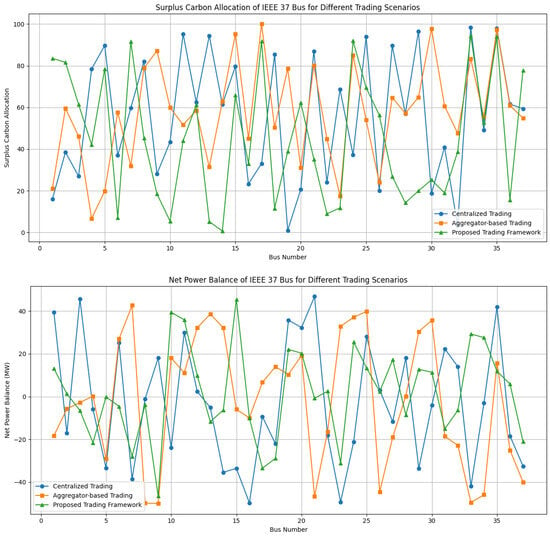
Figure 5.
Surplus carbon allocation of IEEE Bus for different trading scenarios: (1) centralized trading. (2) aggregator-based trading. (3) proposed trading framework.
Additionally, Figure 6 displays the optimal power allocation and costs for each prosumer, determined using the proposed approach, in comparison to a scenario without the initial presumption. In the microgrid, during scheduling periods where prosumers are unable to generate excess energy for trading, there are no energy sellers and therefore, no bidding price. This highlights the interface between organizing and innovative contracts. The proposed auction process is executed using a cutting-edge system on the ‘Ethereum blockchain’.
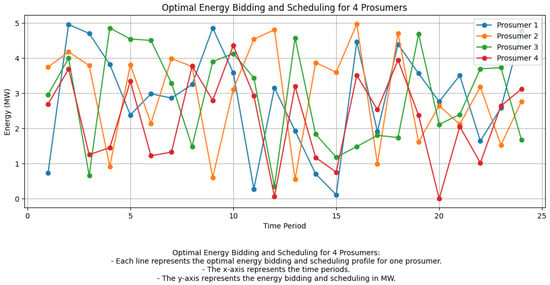
Figure 6.
Optimal power allocation and costs for four prosumers.
The aim of this experiment was to evaluate the effectiveness and efficiency of the carbon allocation auction system in microgrid 5, as depicted in Figure 7. The primary focus of the analysis was to comprehend the functioning of the energy trading among prosumers within the microgrid, with a specific emphasis on the distribution of carbon credits. The experiment was carried out in microgrid 5, with prosumers at ‘bus 706’ and ‘bus 724’ acting as power vendors, offering 319 Wh and 109 Wh of energy, respectively. The energy auction involved multiple buyers and sellers, with the prosumer at bus 724 offering 109 Wh of energy and attracting participation from prosumers at bus 725 and bus 722 as bidders. The auction utilized a bidding process, where prosumers submitted their bids for the available energy, and the highest bidder was declared as the winner. Data were collected on the energy offers from the power vendors (prosumers at bus 706 and bus 724), including the amount of energy offered and the associated carbon emissions. Additionally, bidding data were recorded, documenting the bids submitted by participating prosumers (bus 725 and bus 722) in response to the energy offer at bus 724. The winning bid and the price per kWh were also recorded, along with any other relevant information about the outcome of the auction.
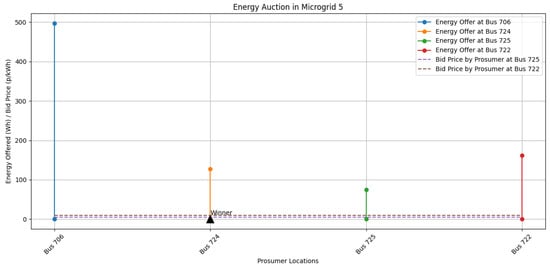
Figure 7.
Optimal Energy Auctions in Microgrid 5.
This analysis focused on the energy offers and carbon emissions of power vendors within a microgrid, with the aim of evaluating the sustainability of the energy being traded. The bidding behavior of prosumers was also examined, to understand their competitiveness in acquiring energy, taking into account factors such as bid prices, strategies, and patterns. The auction mechanism’s efficiency in allocating energy resources was assessed by analyzing the outcome of the auction, including the winning bid and the identity of the successful prosumer. The results revealed any discrepancies or trends in the distribution of energy offers and bids among participating prosumers. Additionally, the impact of carbon allocation on bidding behavior was explored, as prosumers may prioritize bids that align with their sustainability objectives. The effectiveness of the auction mechanism was demonstrated by the winning bid reflecting the market value of the traded energy. The discussion compares the experimental findings to the existing literature on energy trading and carbon allocation mechanisms in microgrids. Furthermore, the implications for policy-making and system optimization are considered, including the potential for incentivizing sustainable energy practices through carbon credit allocation.
Developed Trading Web-Based Application
The web-based trading platform features a simulation of potential households engaged in trading behavior (as shown in Figure 8). Utilizing the Hyperledger Fabric blockchain, the platform converts energy into assets, allowing for the exchange of energy assets between producers and consumers. This not only reduces transaction costs through peer-to-peer trading and automated contracts, but also ensures the participation of utilities as providers of grid infrastructure, energy sellers, and buyers. With its advanced analysis, forecasting, and optimization capabilities, the platform meets the current and future demands of the energy market.
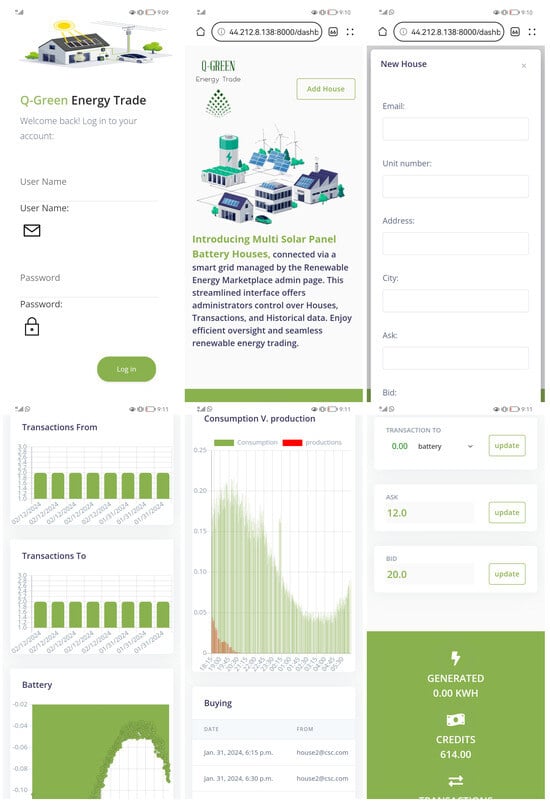
Figure 8.
Developed renewable energy and carbon trading web-based application.
7. Discussion
This research delved into the intricate dynamics of energy trading and carbon allocation within microgrids, shedding light on the effectiveness of auction mechanisms and their impact on prosumer behaviors. The study underscored the significance of efficient market designs in fostering the adoption of renewable energy sources and mitigating carbon emissions in decentralized power systems. To address the challenges of maintaining a regional energy balance and reducing carbon emissions in distribution networks, the authors proposed a peer-to-peer trading system for power allocation exchange. The system leverages a standardized, self-enforcing smart contract that incorporates prosumer algorithms for determining optimal bid and sale prices, along with decision-making for energy reshaping. This innovative contract provides a structured framework for prosumer algorithms to optimize their energy management strategies. The world is witnessing a rapid shift towards renewable energy sources, and microgrids are playing a pivotal role in this transition. Microgrids are localized grids that can operate independently or in parallel with the main grid, providing a more resilient and sustainable power supply. However, managing energy trading and carbon allocation within microgrids remains a complex challenge. This article discusses a novel approach to addressing these challenges through a peer-to-peer trading system for power allocation exchange. This study highlighted the importance of efficient market designs in fostering the adoption of renewable energy sources and mitigating carbon emissions in decentralized power systems. By promoting competition and transparency, market designs can encourage prosumers to invest in renewable energy technologies and adopt energy-efficient practices. To address the challenges of maintaining a regional energy balance and reducing carbon emissions in distribution networks, the authors proposed a peer-to-peer trading system for power allocation exchange. This system leverages a standardized, self-enforcing smart contract that incorporates prosumer algorithms for determining optimal bid and sale prices, along with decision-making for energy reshaping. The innovative contract provides a structured framework for prosumer algorithms to optimize their energy management strategies. By enabling prosumers to trade energy directly with each other, the system reduces the need for intermediaries and centralized control, thereby increasing the efficiency and resilience of the microgrid. The proposed peer-to-peer trading system offers several benefits over traditional energy trading mechanisms: 1. Enhanced efficiency: By eliminating intermediaries and centralized control, the system reduces transaction costs and increases the speed of energy trading. 2. Increased transparency: The standardized smart contract ensures that all prosumers have access to the same information, promoting fairness and transparency in the trading process. 3. Improved sustainability: The system encourages prosumers to invest in renewable energy technologies and adopt energy-efficient practices, thereby reducing carbon emissions and promoting a more sustainable energy future. 4. Greater resilience: The decentralized nature of the system makes it more resilient to disruptions and failures, ensuring a more reliable power supply for consumers. The peer-to-peer trading system proposed in this study offers a novel approach to energy trading and carbon allocation in microgrids. By leveraging a standardized, self-enforcing smart contract, the system enables prosumers to optimize their energy management strategies and trade energy directly with each other. This innovative approach has the potential to enhance efficiency, increase transparency, improve sustainability, and promote greater resilience in decentralized power systems. As the world continues to transition towards renewable energy sources, the adoption of such systems will be crucial in ensuring a more sustainable and resilient energy future.
8. Conclusions
Future research should focus on further exploring the unique characteristics of individual prosumers, including their sensitivity to price variations for power and carbon allocation, as well as their willingness to adjust consumption during peak times. Understanding these individual traits will enable more accurate planning and optimization of bid and sale prices, leading to more efficient and sustainable energy management in microgrids. The application of blockchain technology in the actual trading market holds great promise for revolutionizing energy trading and carbon allocation within microgrids. The proposed peer-to-peer trading system offers a promising solution for power allocation exchange, leveraging a standardized, self-enforcing smart contract that incorporates prosumer algorithms for determining optimal bid and sale prices, along with decision-making for energy reshaping. However, further research and development are needed to address the challenges of understanding individual prosumer characteristics, enhancing prosumer algorithms, ensuring scalability and security, and integrating the system with existing energy infrastructure. The proposed system aims to create a more transparent, efficient, and decentralized energy market, where prosumers can actively participate in the trading process and benefit from the adoption of renewable energy sources. By enabling prosumers to trade energy and carbon credits directly with each other, the system can reduce transaction costs, increase market liquidity, and promote the growth of renewable energy generation. Moreover, the use of blockchain technology can enhance the security and reliability of the trading system, as it provides a tamper-proof and transparent ledger of all transactions. This can help to build trust among prosumers and encourage greater participation in the energy market. In conclusion, this research on energy trading and carbon allocation within microgrids highlights the importance of efficient market designs and the potential of blockchain technology to revolutionize the energy sector. The proposed peer-to-peer trading system offers a promising solution for power allocation exchange, but further research and development are needed to address the challenges of understanding individual prosumer characteristics, enhancing prosumer algorithms, ensuring scalability and security, and integrating the system with the existing energy infrastructure. By addressing these challenges, we can create a more sustainable and efficient energy market that benefits both prosumers and the environment.
Funding
This research was funded by the Qatar National Research Fund through grant AICC05-0508-230001, Solar Trade (ST): An Equitable and Efficient Blockchain-Enabled Renewable Energy Ecosystem—“Opportunities for Fintech to Scale up Green Finance for Clean Energy”.
Data Availability Statement
Data are contained within the article.
Acknowledgments
Partial support from Qatar National Research Fund through grant AICC05-0508-230001, Solar Trade (ST): An Equitable and Efficient Blockchain-Enabled Renewable Energy Ecosystem—“Opportunities for Fintech to Scale up Green Finance for Clean Energy”, and from the Qatar Environment and Energy Research Institute are gratefully acknowledged.
Conflicts of Interest
The authors declare no conflicts of interest.
References
- Chiu, W.-Y.; Sun, H.; Poor, H.V. Energy imbalance management using a robust pricing scheme. IEEE Trans. Smart Grid 2013, 4, 896–904. [Google Scholar] [CrossRef]
- Di Silvestre, M.L.; Gallo, P.; Ippolito, M.G.; Sanseverino, E.R.; Zizzo, G. A technical approach to the energy blockchain in microgrids. IEEE Trans. Indust. Inform. 2018, 14, 4792–4803. [Google Scholar] [CrossRef]
- Fan, J.; Li, J.; Wu, Y.; Wang, S.; Zhao, D. The effects of allowance price on energy demand under a personal carbon trading scheme. Appl. Energy 2016, 170, 242–249. [Google Scholar] [CrossRef]
- Hua, W.; Li, D.; Sun, H.; Matthews, P. Stackelberg game-theoretic model for low carbon energy market scheduling. IET Smart Grid 2020, 3, 31–41. [Google Scholar] [CrossRef]
- Kang, C.; Zhou, T.; Chen, Q.; Wang, J.; Sun, Y.; Xia, Q.; Yan, H. Carbon emission flow from generation to demand: A network-based model. IEEE Trans. Smart Grid 2017, 6, 2386–2394. [Google Scholar] [CrossRef]
- Shindell, D.; Smith, C.J. Climate and air-quality benefits of a realistic phase-out of fossil fuels. Nature 2019, 573, 408–411. [Google Scholar] [CrossRef] [PubMed]
- Klinthong, S.; Tantayanon, S.; Wuttipan, W.; Thiravong, S.; Chantawarangkul, P.; Sangaroon, S.; Piumsomboon, P. Decarbonizing a Thai Coal Power Plant: Effect of Flue Gas Loads on Carbon Capture Performance and Economics. Appl. Energy Lett. 2024, 9, 1–10. [Google Scholar] [CrossRef]
- Mengelkamp, E.; Weber, I.; Scholz, R. A survey on blockchain-based energy trading. Renew. Sustain. Energy Rev. 2018, 93, 377–392. [Google Scholar]
- Zhang, Y.; Zhang, Y.; Zhang, J. Blockchain-based energy trading: A review. Renew. Sustain. Energy Rev. 2019, 108, 109308. [Google Scholar]
- Kumar, A.; Kaur, S.; Kumar, A. Blockchain-based peer-to-peer energy trading: A review. Renew. Sustain. Energy Rev. 2020, 122, 109710. [Google Scholar]
- Thomas, L.; Zhou, Y.; Long, C.; Wu, J.; Jenkins, N. A general form of smart contract for decentralized energy systems management. Nat. Energy 2019, 4, 140–149. [Google Scholar] [CrossRef]
- van Leeuwen, G.; AlSkaif, T.; Gibescu, M.; van Sark, W. An integrated blockchain-based energy management platform with bilateral trading for microgrid communities. Appl. Energy 2020, 263, 114613. [Google Scholar] [CrossRef]
- Zeyringer, M.; Price, J.; Fais, B.; Li, P.-H.; Sharp, E. Designing low-carbon power systems for Great Britain in 2050 that are robust to the spatiotemporal and inter-annual variability of weather. Nat. Energy 2018, 3, 395–403. [Google Scholar] [CrossRef]
- Boumaiza, A. A Blockchain-Based Scalability Solution with Microgrids Peer-to-Peer Trade. Energies 2024, 17, 915. [Google Scholar] [CrossRef]
- Boumaiza, A.; Sanfilippo, A. Peer to Peer Solar Energy Trading Demonstrator Blockchain-enabled. In Proceedings of the 2023 11th International Conference on Smart Grid (icSmartGrid), Paris, France, 4–7 June 2023; pp. 1–7. [Google Scholar] [CrossRef]
- Boumaiza, A.; Sanfilippo, A. AI for Energy: A Blockchain-based Trading Market. In Proceedings of the IECON 2022—48th Annual Conference of the IEEE Industrial Electronics Society, Brussels, Belgium, 17–20 October 2022; pp. 1–6. [Google Scholar] [CrossRef]
- Tapscott, D.; Tapscott, A. Blockchain Revolution: How the Technology behind Bitcoin Is Changing Money, Business, and the World; Penguin: London, UK, 2017. [Google Scholar]
- Wang, Y.; Wang, W.; Li, B. Blockchain-based carbon trading platform: A decentralized and transparent solution. Sustainability 2021, 13, 6460. [Google Scholar]
- Li, J.; Li, J.; Xu, H. A survey of blockchain-based carbon trading. IEEE Access 2022, 10, 11680–11693. [Google Scholar]
- Zhang, Y.; Wang, W.; Li, B. A comprehensive review of blockchain applications in carbon trading. Appl. Energy 2022, 323, 119656. [Google Scholar]
- WWF. Blockchain for Carbon Markets: A Guide for Policymakers. 2022. Available online: https://wwfint.awsassets.panda.org/downloads/blockchainforcarbonmarketsaguideforpolicymakerswwf2022.pdf (accessed on 20 April 2024).
- Boumaiza, A.; Sanfilippo, A. Blockchain For Transactive Energy Marketplace. In Proceedings of the 2023 IEEE 32nd International Symposium on Industrial Electronics (ISIE), Helsinki, Finland, 19–21 June 2023; pp. 1–5. [Google Scholar] [CrossRef]
- Surana, K.; Jordaan, S.M. The climate mitigation opportunity behind global power transmission and distribution. Nat. Clim. Chang. 2019, 9, 660–665. [Google Scholar] [CrossRef]
Disclaimer/Publisher’s Note: The statements, opinions and data contained in all publications are solely those of the individual author(s) and contributor(s) and not of MDPI and/or the editor(s). MDPI and/or the editor(s) disclaim responsibility for any injury to people or property resulting from any ideas, methods, instructions or products referred to in the content. |
© 2024 by the author. Licensee MDPI, Basel, Switzerland. This article is an open access article distributed under the terms and conditions of the Creative Commons Attribution (CC BY) license (https://creativecommons.org/licenses/by/4.0/).